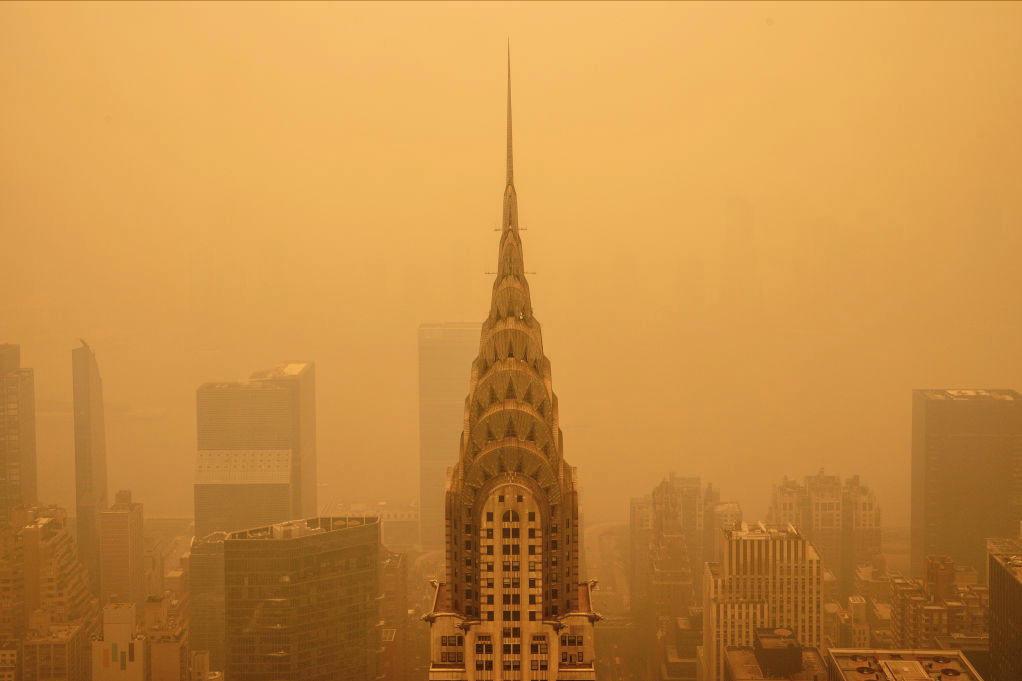According to the National Weather Service, the smoke from eastern Canada’s wildfires has triggered ai quality alerts across the East Coast and has led to record poor air quality in the eastern US. Cities such as New York City. Several Canadian cities are also experiencing poor air quality in places such as Toronto and Ottawa, many of whom are experiencing this for the first time. As more than 400 wildfires rage in Quebec, according to the Canadian Interagency Forest Fire Center, the air quality has continued to deteriorate and poses a significant health risk, especially to vulnerable populations such as children.
Symptoms:
The fine particles and toxic gases present in wildfire smoke can have severe respiratory and health implications. The symptoms to look out for vary and include:
- Respiratory symptoms: coughing, shortness of breath, wheezing, and chest discomfort.
- Nasal and throat symptoms: runny of stuffy nose, sneezing, and sore throat.
- Eye irritation: redness, and watery eyes (excessive tearing or watering of the eyes);
- Headache and dizziness;
- Fatigue and irritability: children who are exposed to wildfire smoke may feel tired, lethargic, or unusually irritable.

As parents, it is crucial to take proactive steps to protect our children from these hazardous conditions. In this blog post, we will explore essential strategies and safety measures to safeguard children against wildfire smoke exposure, backed by reliable sources.
- Understand the Risks and Effects of Wildfire Smoke: To effectively protect our children, it is essential to comprehend the risks and potential health effects of wildfire smoke exposure. Wildfire smoke consists of fine particulate matter (PM2.5), which can penetrate deep into the lungs, causing respiratory issues, exacerbating asthma, and increasing the risk of infections. According to the Centers for Disease Control and Prevention (CDC), exposure to wildfire smoke can lead to a range of health problems, including coughing, wheezing, shortness of breath, and increased susceptibility to respiratory infections.
- Monitor Air Quality and Stay Informed: Regularly monitoring air quality is vital to assess the level of smoke exposure in your area. Utilize reputable sources such as AirNow (airnow.gov) or your local air quality monitoring agency to stay informed about real-time air quality data and wildfire updates. The Environmental Protection Agency (EPA) provides a comprehensive guide on air quality index (AQI) and its interpretation (source: EPA’s Air Quality Index – A Guide to Air Quality and Your Health).
- Create a Clean Indoor Environment: When wildfire smoke is present, creating a clean indoor environment is crucial for minimizing exposure. Close all windows and doors to prevent smoke from entering the house. Use weatherstripping or caulk to seal any gaps. Additionally, employ high-efficiency particulate air (HEPA) filters or air purifiers to remove smoke particles from the indoor air. The American Lung Association recommends using portable air cleaners with a Clean Air Delivery Rate (CADR) appropriate for the room size (source: American Lung Association’s “Wildfires and Indoor Air Quality”).
- Minimize Outdoor Activities: During periods of poor air quality, limit outdoor activities for your children to minimize smoke exposure. Encourage indoor activities that keep them engaged and entertained, such as reading, puzzles, or arts and crafts. Indoor exercise options like dancing or yoga can help maintain physical activity levels while reducing exposure to outdoor pollutants.
- Use Proper Respiratory Protection: When venturing outdoors in smoky conditions, it is crucial for children to wear proper respiratory protection, such as N95 masks or respirators. These masks can filter out a significant portion of the fine particles present in wildfire smoke. Ensure the masks fit properly, cover the nose and mouth completely, and are worn consistently. Educate your children on the importance of wearing masks and avoiding touching their faces while wearing them. Due to fit issues as a result from their smaller faces, N95s may not be the best option for a child. However, options such as KN95 or KF94 masks that are designed for children can be used instead. The California Department of Public Health provides guidance on choosing and using masks for protection against wildfire smoke (source: California Department of Public Health’s “Using Masks to Protect from Wildfire Smoke”).
- Stay Hydrated and Maintain a Healthy Diet: During periods of smoke exposure, it is crucial to keep your children hydrated and maintain a healthy diet. Drinking plenty of water helps flush out toxins from the body and keeps the respiratory system moist. Ensure your children consume a balanced diet rich in fruits, vegetables, and whole grains, as these provide essential nutrients that support immune function and respiratory health.
Conclusion:
Protecting children from the health risks associated with wildfire smoke exposure requires proactive measures, staying informed, and implementing safety strategies. By understanding the risks, monitoring air quality, creating a clean indoor environment, minimizing outdoor activities, using proper respiratory protection, and following expert advice, parents can significantly reduce their children’s exposure to wildfire smoke. Additionally, being prepared with emergency kits and evacuation plans and maintaining good hygiene practices contribute to overall well-being during wildfire events. Remember to consult reliable sources, such as government agencies and reputable health organizations, for the most up-to-date information and guidance.

